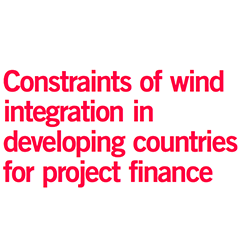Olivier Texier takes a look at the main challenges behind wind power forecasting, how some grid operators and/or energy off-takers introduce power forecasting constraints for wind power plant, and what the implications might be for developers and financiers.
With the increased penetration of intermittent renewable energy such as wind and solar into modern grids, there is need for better dispatch tools in order to maintain grid stability at all times. This is especially true in developing countries that do not always have sufficient spinning reserves or installed capacity to cope with sudden generation fluctuation from wind and solar farms. Short-term wind power forecasting may well be one of the tools and proposes to provide estimates of power generation from a wind farm.
In industrialised countries, it is often the case that wind energy gets first dispatch, e.g., all energy produced is injected into the grid regardless of fluctuations. The reason for this operational approach is that, in most instances, wind generation only represents a small portion (with a few exceptions like Ireland and Denmark) of the installed capacity and therefore the fluctuations are non-material compared to total generation. In developing countries, however, the situation is more challenging because of the lack of grid infrastructure or installed capacity.
As a consequence, we have witnessed recent developments in some countries whereby the Power Purchase Agreement (PPA) or the Grid Connection Agreement (GCA) introduces provisions on wind forecasting obligations for the projects. In this article, we will examine what form such provisions can take and what level of certainty the current wind power forecasting tools can provide to comply with the obligations.
Wind power grid integration in developing countries
The two main constraints grid operators in developing countries usually face with regard to their power infrastructure are the lack of installed capacity by comparison to the potential demand and the lack of interconnection with neighbouring countries. The former means that a new wind farm usually has a greater impact on grid stability than in industrialised countries. This is usually reinforced by fewer planning constraints in developing countries, allowing for greater installed capacity in one site.



























